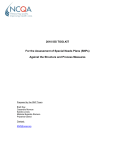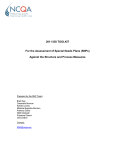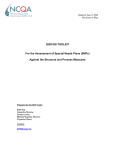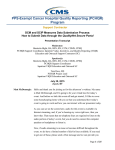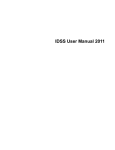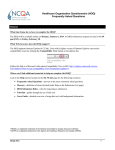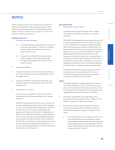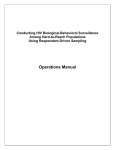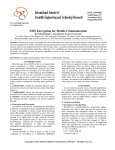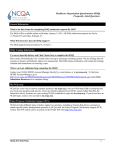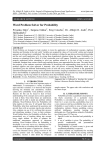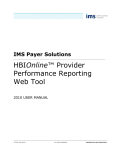Download ISS Toolkit
Transcript
2013 ISS TOOLKIT For the Assessment of Special Needs Plans (SNPs) Against the Structure and Process Measures Prepared by the SNP Team: Brett Kay Casandra Monroe Sandra Jones Anthony Davis Nidhi Dalwadi Priyanka Oberoi Ling Chen Delia Ponce Contact: [email protected] 2013 ISS TOOLKIT Table of Contents I. SNP Reporting Key Messages 3 II. Reporting Requirements by SNP Type/Element 5 III. Data Sources by Element and Examples of Data Sources IV. Guidelines for a Successful Evaluation of a Special Needs Plan (SNP) Against the 2013 Structure & Process Measures 10-17 V. Preparing Documentation for Surveys 19-28 VI. Steps and Screenshots for Key Activities 30-48 VII. ISS Documentation Tips 7-8 50 2 2013 ISS Toolkit - SNP Reporting Key Messages The following key messages are important and should be used to guide you through your organization‘s readiness evaluation and the ISS tool submission process. If your organization has more than one Special Needs Plan (SNP) benefit package, you must submit a separate survey tool for every SNP benefit package. Use the name of the SNP, H-number and plan ID to identify the correct survey tool. Prepare to submit ISS tool(s) early to avoid internet traffic delays but do not submit your ISS tool(s) later than October 15, 2013. Each SNP survey tool has a 1-4 person user license. Your organization‘s ISS administrator (this is the person who was sent the tool originally) can give three other individuals access to each of your survey tools. Do not push the ―Submit Survey Tool‖ button unless your survey tool is complete and you are ready for NCQA surveyors to start the survey process. You must attach documentation to demonstrate performance for all factors and elements. When preparing for a survey please review the S&P measures, FAQs, any policy clarifications and training materials NCQA releases updating or clarifying the requirements. FAQs and policy clarifications are effective upon release (unless noted otherwise). 3 Reporting Requirements for SNP Type/Element 4 2013 ISS Toolkit – Reporting Requirements by SNP Type/Element Measure/Element Measure - SNP 1: Care Management and Coordination New Surveys Reporting (Y or N) Returning Surveys Reporting (Y or N) SNP Type Exceptions Element A: Care Management Program Description Element B: Population Assessment Element C: Care Management Assessment Process Element D: Individualized Care Plan Element E: Satisfaction with Care Management Element F: Analyzing Effectiveness/Identifying Opportunities Element G: Implementing Interventions and Follow-up Evaluation Measure - SNP 2: Improving Member Satisfaction Y Y Y Y N N N Element A: Assessment of Member Satisfaction Element B: Opportunities for Improvement Element C: Improving Satisfaction Measure - SNP 3: Clinical Quality Improvements Element A: Clinical Improvements Measure - SNP 4: Care Transitions Y 1/ Y 1/ Y Y 1/ Y 1/ Y N Y Element A: Managing Transitions Element B: Supporting Members Through Transitions Element C: Analyzing Performance Element D: Identifying Unplanned Transitions Element E: Analyzing Transitions Element F: Reducing Transitions Measure - SNP 5: Institutional SNP Relationship With Facility Y Y 1/ Y Y 1/ Y Y Y Y 1/ Y Y 1/ Y Y Element A: Monitoring Members‘ Health Status Y Y Not for Chronic/Duals Element B: Monitoring Changes in Members‘ Health Status Element C: Maintaining Members‘ Health Status Measure - SNP 6: Coordination of Medicare and Medicaid Coverage Element A: Coordination of Benefits for Dual-Eligible Members Element B: Administrative Coordination for Dual-Eligible SNPs Element C: Administrative Coordination for Chronic Condition & Inst. BP Element D: Service Coordination Element E: Network Adequacy Assessment Y Y Y Y Not for Chronic/Duals Not for Chronic/Duals Y Y Y Y Not for Chronic/Institutional Not for Chronic/Institutional 1/ 2/ Y 2/ Y 1/ 2/ Y Y Y Y Y 1/ Y 1/ Y 1/ Y 1/ 2/ Y Not for Duals 2/ Y 1/ 2/ Y EXCEPTIONS 1 / Not applicable (NA) for a SNP that does not have any members at the start of the look-back period; NCQA will verify enrollment data with the April 2013 CMS Comprehensive Report. 2/ Not applicable (NA) for Chronic and Institutional SNPs with fewer than 5% dual-eligible members. 5 Data Sources by Element and Examples of Data Sources 6 2013 ISS Toolkit Data Sources by Element SNP SNP 1: Care Management and Coordination Element A Element B Element C Element D Element E Element F Element G SNP 2: Improving Member Satisfaction Element A – for each factor Element B – for each factor Element C– for each factor SNP 3: Clinical Quality Improvements Element A SNP 4: Care Transitions 1 Element A – for each factor Element B – for each factor Element C – for each factor Element D – for each factor Element E – for each factor Element F – for each factor SNP 5: Institutional SNP Relationship with Facility Element A Element B Element C SNP 6: Coordination of Medicare and Medicaid Coverage Element A Element B Element C Element D Element E – for each factor Data Sources Documented Processes Documented Processes Documented Processes AND Reports OR Materials Documented Processes AND Reports OR Materials Reports AND MAY PROVIDE Documented Processes Reports AND MAY PROVIDE Documented Processes Reports AND MAY PROVIDE Documented Processes Documented Processes AND Reports Documented Processes AND Reports Documented Processes AND Reports Reports Documented Processes AND reports OR materials Documented Processes AND reports OR materials Documented Processes AND reports Documented Processes AND reports Documented Processes AND reports Documented Processes AND reports OR materials Documented processes AND reports OR materials Documented processes AND reports OR materials Documented processes AND reports Reports AND MAY PROVIDE documented processes OR materials Documented processes AND reports OR Materials Documented processes AND reports OR materials Documented processes AND reports OR materials Documented processes AND reports If you would like examples of documented processes, reports or materials, please refer to the Data Sources Examples document or the Guidelines for a Successful Evaluation of a Special Needs Plan (SNP) Against the 2013 Structure & Process Measures document. 1 SNPs must provide the required data sources to demonstrate performance specific to each factor. For example, for SNP 4, Element A, factor 1, the SNP must provide documented processes AND reports/materials. For factor 2, the SNP must provide documented process AND reports/materials. This applies to each element in SNP 4. 7 2013 ISS Toolkit Examples of Data Sources Documented Process - A documented process includes policies and procedures, process flow charts, protocols and other mechanisms that describe the actual processes a SNP uses. Reports - Reports are aggregated sources of evidence of action or compliance with an element. Materials - Prepared materials or content the organization provides to its members and practitioners. Documented Process* Policies and procedures with timeframes where appropriate Procedures for arranging services Procedures for ordering services from providers Contracts or agreements (especially for facilities‘ responsibilities with institutional SNPs and administering Medicaid benefits to dualeligibles) Procedures for network facilities to provide updates on members‘ health Evidence of Coverage (EOC) Models of Care (MOCs) Materials* Briefing materials Checklists Scripts Education materials Brochures Information prepared for members‘ experiencing transitions Benefit summaries Marketing materials Instructional materials Provider directory Provider manuals Newsletters Reports* Evidence of Coverage (EOC) Management reports Key indicator reports Redacted reports (daily, monthly) Redacted reports that show predictive modeling Reports on overall rates of admission Reports showing aggregate analysis Summary reports of analysis System output giving information Meeting minutes Documentation of actions that the SNP has taken Written notification of scheduled meeting with state or state acknowledgement of receipt Reports on access indicators Screen shots (Actual reports required) * This list is not all-inclusive 8 Guidelines for a Successful Evaluation of a Special Needs Plan (SNP) Against the 2013 Structure & Process Measures 9 Guidelines for a Successful Evaluation of a Special Needs Plan (SNP) Against the 2013 Structure & Process Measures Welcome to the Structure & Process Measures survey process. The guidelines and resources contained in this document will help you prepare for your organization‘s survey and maximize the efficiency of your preparation time. SNP Survey Process Readiness Evaluation NCQA‘s Web-based Survey Tool for the Evaluation of a Special Needs Plan allows your organization to perform a readiness evaluation at its own pace before submitting data to NCQA. You may assess your program‘s operations and evaluate your performance against the Structure & Process Measures. During the readiness evaluation stage, NCQA does not view your information; therefore, you can use the tool to its full capacity and evaluate your organization in a variety of ways. Evaluation by NCQA The NCQA survey process begins with the submission of the Survey Tool which is final upon receipt by NCQA. All Survey Tools are due to NCQA no later than October 15, 2013. If you have specific questions about your preparation contact Customer Service at 888-275-7585, 8:30 a.m.–5:00 p.m. Eastern Time or via e-mail at [email protected]. Preparing for the Readiness Evaluation 1. To facilitate the process, you may find it helpful to keep documents that you link to the Survey Tool in a single directory shared by all your users. This will facilitate multiple users working on the Survey Tool. You can modify, move or rename a linked document, since it is not final until you submit it to NCQA for the evaluation. If you move or rename documents, be sure to update the links in the Survey Tool before your final submission. 2. The Document Library includes a list of all documents loaded to your Survey Tool. From here, you can link, unlink or edit documents 10 for any element. Refer to the instructions under the Help tab for detailed information. You can also add documents to the library without linking them to a specific element. This feature allows you to "load" your documents so that they are available in a list of documents that you can access when you need to link a document to an element during your readiness evaluation. NCQA limits the types of documents you may send (see the list of recommended supporting documents at the end of these guidelines.) NCQA encourages you to submit only documents, pages or sections necessary to demonstrate how your organization meets the requirements in the measures. Preparing your documentation for submission in ISS requires you to follow several steps. The Toolkit contains written instructions and screenshots to walk you through each process. You must: 1) load your documents to the Document Library; and 2) link the documents to the appropriate element(s). For instructions on loading and linking documents, please refer to pages 30-32 of the section titled Steps and Screenshots for Key Activities. This document walks you through each activity and directs you to several screenshots which illustrate the steps you need to follow such as: screenshots 7A-7C (loading documents) and 7D-7E (linking documents). In addition, you may wish to view a demo within the ISS Tool on how to do this. Select Help and Instructions on the dark blue tool bar; scroll down to ISS Demonstrations and click on Document Library. Utilizing the available resources and following each of these steps are essential for successful preparation of your documentation for the submission process. Completing the Survey Tool Print out and use the instructions in the Survey Tool, which you can access by clicking the Help button on the Navigation Bar on the opening screen. The Structure & Process Survey Tool instructions appear on the next screen. They provide all the information necessary to successfully navigate and complete the tool and complete your readiness evaluation. As you assess your performance with each factor and element, be sure to: 11 1. Preload your document library with essential documents that demonstrate performance against the measures. 2. Evaluate each element and load the appropriate document(s) that demonstrates performance by linking it to an existing library document or, if necessary, load a new document and link it by clicking the Add Link button. Each factor and element must have supporting documentation. If possible, limit supporting documentation to no more than three documents per element. For detailed instructions please refer to the section titled: Steps and Screenshots for Key Activities which starts on page 30 (be sure to view screenshots 7A-7E) of this guide. After entering a data element, save it before moving on by clicking the Save button or the Next Standard button. 3. For each supporting document listed, you must: • identify the page number containing the information that supports the factor or element, as specified in the Survey Tool. • attach only pages and sections necessary to demonstrate how your organization meets the measures, as well as any cover page that identifies the document and, if applicable, provides its date. If you reference a document multiple times, you may place the entire document in the document library and reference different pages and paragraphs throughout your assessment. If you wish to stop using the Survey Tool, click on the Log Out button located on the Navigation Bar. You should log out even if you only plan a short break. This will properly notify the system that you are done with your session. If you do not log out, the Survey Tool will ―time-out‖ after 30 minutes of inactivity. 12 NCQA Resources Online Support PCS FAQs NCQA‘s SNP Web page, http://www.ncqa.org/snp contains a wealth of information that includes recent news from NCQA, the Policy Clarification Support (PCS) system, policy clarifications and updates, and slides and audio recordings of SNP trainings. Send any questions about interpretation of the Structure & Process measures through the PCS system on the NCQA Web site at http://ncqa.force.com/pcs/login FAQs are available on the SNP page of NCQA‘s Web site http://www.ncqa.org/snp 13 Recommended Supporting Documents Ensure that your documents, policies, procedures, reports and materials address all aspects of each factor and element. The following is a list of documents recommended to attach as evidence of performance so the NCQA surveyor may complete the evaluation of your SNP plan against the Structure & Process measures. The list is not intended to be all-inclusive or prescriptive. Measure SPECIAL NEEDS PLANS SNP 1 Documents* For Element A (New Element), a program description or policies and procedures that detail how the organization‘s care management program is structured. These documents also identify the evidence it used to develop the program, along with the services it provides and program goals. For Element B (New Element), policies and procedures that detail how the SNP: 1) assesses the characteristics of the population in the care management program, 2) reviews and updates care management processes and 3) reviews and updates resources to address members‘ needs. For Element C (Previously Element F), policies and procedures and reports or materials are required. These documents must show the organization has procedures and how it conducts an initial assessment of each member that enables it to obtain eight specific types of information that address each factor in the element. For Element D (Previously Element G), policies and procedures, reports or materials that detail how the SNP develops individualized care plans for members that address the five required factors. For Element E (Previously Element I), reports containing an analysis of a care management satisfaction survey, complaints and inquiries. For Element F (Previously Element J), reports showing the analysis of three relevant measures to assess the effectiveness of the care management program. For Element G (Previously Element K), reports showing interventions implemented and policies that describe plans for assessing intervention effectiveness and remeasurement. SNP 2 For Elements A and B: Reports demonstrating an evaluation of member complaint and appeal data (including how the population was identified, sampling methodology and collection of valid data). 14 Reports showing an organization’s analysis of CAHPS results and opportunities for improvement it identified if used. Reports demonstrating identification of opportunities for improvement. For Element C, reports showing intervention implemented and the evaluation of the intervention effectiveness. Organizations with no members at the start of the look-back period may select not applicable (N/A); however, you must provide information to support the N/A claim and NCQA will verify with the April 2013 CMS Comprehensive Report. SNP 3 SNPs do not need to supply any documentation for this element; NCQA staff will review HEDIS results submitted previously. Organizations with less than 30 members per the February 2012 CMS Comprehensive Report will receive a score of not applicable (N/A). SNP 4* *Please note that two data sources (e.g., documented processes and reports/materials) are required for each factor of every element in SNP 4. (Element A) Policies and procedures detailing the organization‘s process for identifying and managing planned/unplanned transitions between care settings which include timeframes for specified activities. Policies and procedures with specified timeframes that show how the SNP notifies the member‘s usual practitioner of a transition. (Element B) Procedures with specified timeframes that demonstrate: --how the SNP communicates changes in members‘ conditions to member and or responsible party; and --how the SNP educates member and/or responsible party regarding the transition process. (Element C) Reports demonstrating aggregate analysis of performance managing transition tasks (Element D) Policies and procedures for reporting by contracted entities (Element D) Reports on daily admissions or staff notification of transitions (Element E) Reports detailing an analysis of admissions and ER visits which indicates -- how the SNP implements an intervention to reduce unplanned transitions 15 Elements C and E require documented processes and reports. For Elements C and E, SNPs with no members at the start of the lookback period may select not applicable (N/A); however, you must provide information to support the N/A claim and NCQA will verify with the April 2013 CMS Comprehensive Report. SNP 5 (Element F) Policies and procedures for case managers or other staff to contact members at-risk for a transition and arrange services. (Element A) Policies and procedures that demonstrate: --how the SNP receives updates from facilities on members care and monitors their health (Element B) Procedures delineating how: 1) the organization and facilities respond to changes in members‘ health status and triggering events; and 2) the member‘s care is coordinated with appropriate clinicians or care plan. (Elements A and B) Contracts or agreements with facilities covering their reporting responsibilities (Elements A and B) Reports (such as MDS) or materials of how member health status data is collected (Elements A and B) Job descriptions of staff that visit members and reports they provide on changes in members‘ health status (Elements A and B) Briefing materials distributed by facilities. (Element C) Screenshots of the care management system showing monitoring, assessments and care plan changes after a member‘s health status change along with discussions between nurse managers and treating practitioners regarding them. Elements 5A, 5B and 5C are not applicable (N/A) for Institutional SNPs that do not have any contracts with nursing or assisted living facilities and for Chronic condition and Dual-eligible benefit packages. SNP 6 (Element A) Reports that demonstrate how the SNP coordinates Medicaid and Medicare benefits and services (Element A) Evidence of coverage documents (Element B) Procedures and reports used to determine Medicaid eligibility and changes in members‘ Medicaid eligibility. 16 (Elements B and C) Instructional materials distributed to members or responsible parties on where to reapply for Medicaid. (Elements B and C) Job descriptions, procedures and scripts used by staff that assist members with information on Medicare and Medicaid: eligibility, benefits and claims (Element C) Procedures for administering Medicaid benefits; and acknowledgment of receipt of instructional materials from state on how to administer Medicaid benefits. (Element D) Policies and procedures for arranging services for members along with provider directories, provider manuals. (Element E) Policies containing standards for the numeric and geographical distribution of practitioners and providers as well as the methodology used to assess network adequacy; reports showing an evaluation of network adequacy for practitioners and providers that accept members‘ Medicare and Medicaid benefits. Elements 6A and 6B are not applicable (N/A) for Chronic condition and Institutional benefit packages. An organization that does not have a contract with the state to adjudicate Medicaid claims can meet the intent of Element 6B factor 2 by providing a documented process and reports/materials that show it helps members understand the states’ adjudication of claims submitted by providers. Element 6C is not applicable (N/A) for all Dual Eligible SNPs and Chronic and Institutional SNPs with fewer than 5% dual-eligible members; however, Chronic and Institutional SNPs must provide documentation to support the N/A claim and NCQA will verify with enrollment data from CMS. Elements 6D and 6E are not applicable (N/A) for Chronic condition and Institutional SNPs with fewer than 5% dual-eligible members are not required to report; however, you must provide documentation to support the N/A claim and NCQA will verify with enrollment data from CMS. For security reasons, including the protection of the data and documents you send to us, we limit the types of documents you may send. The permitted file types are .CSV, .DOC, .DOCX, .GIF, .JPG, .MPP, .PDF, .PPT, .PPTX, .RTF, .TXT, .VSD, .XLS, and .XLSX. We cannot accept files in other formats. Please note that most other formats can be converted to .GIF, or .JPG via scanner, or to PDF using Adobe® Acrobat®. ** Please do not attach documents that contain Protected Health Information (PHI) to the survey tool. 17 Preparing Documentation for Surveys 18 Preparing Documentation for Surveys An important part of any NCQA survey is document preparation. NCQA determines if an organization meets an element or factor based on what the organization‘s documents – such as policies, program descriptions, activity reports, member materials, and other work products – demonstrate. The documents show what you as an organization do. How you prepare those documents and present them to NCQA, in other words, how you tell your story, can make it easier for the NCQA survey team to confirm that you meet the requirements. This can result in a simpler and more streamlined survey experience, with fewer requests from the survey team for clarification or additional information during Plan Comment. Your objective should be to provide the NCQA survey team with the information necessary to accurately evaluate performance against the Structure and Process (S&P) measures in as directed and efficient a manner as possible. Keep in mind that the goal of the surveyor is to confirm that your organization meets the intent of the requirements; therefore, the clearer it is that it has met the intent; the easier it is for the surveyor to confirm the organization‘s performance. However, the organization is ultimately responsible for documenting its performance and directing the surveyor to that documentation. The purpose of this document is to provide direction on preparing documents and developing a documentation guide, which helps the surveyor navigate through the information attached to your survey tool. It has three sections: How the S&P Measures are Structured: This section provides an overview of the components of a measure and its elements, with an emphasis on how to determine what documentation is needed Document Preparation: This section describes how to prepare documents, with suggestions on how to compile information, highlight key sections in documents and direct surveyors to the specific information that demonstrates you meet an element. It also explains how NCQA will handle situations where it cannot find evidence of performance in the documentation – either because it does not appear to be there or because the documents are not presented in a manner that makes it easy to find. Documentation Guide: This section provides an overview of what a documentation guide is and how it assists NCQA in the review of your documents. It also provides examples of how to compose a documentation guide. 19 How the S&P Measures are Structured In order to know what type of information and documentation to provide to the survey team, it is important to understand how the measures are structured. Each S&P measure includes the following key information: Standard Statement: An actual statement that describes acceptable performance or results. Intent Statement: The statement that describes the importance, purpose and meaning of the measure. Element: The component of a measure that is scored and provides details about performance expectations. NCQA evaluates each element within a measure to determine the degree to which the organization meets the requirements within the measure. Factor: An item within an element that is scored. For example, an element may require the organization to demonstrate that a specific document addresses four items; each item is a factor. Data Source: the types of documentation or evidence that the organization must use to demonstrate performance with an element. NCQA defines four types of data sources, however, for the SNP S&P measures assessment, NCQA does not currently require records/files: 1. Documented process: Policies and procedures, process flow charts, protocols and other mechanisms that describe an actual process used by the organization. 2. Reports: Aggregated sources of evidence of action or performance with an element, including program evaluation management reports; key indicator reports; summary reports from member reviews; system output giving information like number of member appeals; minutes; and other documentation of actions that the organization has taken. 3. Materials: Prepared materials or content that the organization provides to its members or practitioners including written and electronic communication, information from Web sites, scripts, brochures, newsletters and clinical guidelines. 4. Records or Files: Actual records or files that show direct evidence of action or performance with an element. If multiple data sources are listed for an element, the explanation section provides direction on what evidence the organization must provide to meet the requirements. Scope of Review: The extent of the organization‘s services evaluated during an NCQA survey. Look-back Period: The period of time for which NCQA evaluates an organization‘s documentation to assess performance against an element. NCQA measures the lookback period from the point of the organization‘s submission of the completed Survey 20 Tool. Unless otherwise noted, organizations must meet the requirement throughout the look-back period. Explanation: Specific requirements that the organization must meet, and guidance for demonstrating performance against the element. Examples: Descriptive information illustrating performance against an element‘s requirements. Examples are provided for guidance only and are not specifically required or all-inclusive. Be sure to consider all pertinent information provided by NCQA under each measure and element in the Survey Tool (e.g., each of the information sources described in the section above). If the data source specifies ―documented process‖ and the organization provides a report, it has not demonstrated full performance. Likewise, if the look-back period specifies 6 months, and the organization provides evidence of completion of the activities that is dated 12 months prior to the survey date, then it has not demonstrated performance with the requirements. Document Preparation NCQA surveyors serve as fact finders for organizations, verifying that that the documentation presented meets the intent of the requirements. The organization‘s obligation is to present the documentation that demonstrates performance and to do so in a manner that facilitates review by the NCQA survey team. The organization is expected to: Provide the required documents Present them in an organized, readable format Limit documentation to the minimum necessary to demonstrate performance Use available software features and tools (such as highlighting and comments) to direct the surveyors to evidence of performance. If the surveyors do not find the specified evidence in the documents, they will ask for clarification during Plan Comment and provide the organization an opportunity to respond. The survey team does not summarily score an element less than 100 percent without notification to the organization of the issues. When an organization provides numerous documents, clear evidence of performance may not be obvious or apparent to the surveyor. However, the onus is on the organization to demonstrate its performance with each of the requirements. 21 What is the Best Way to Prepare Documentation for the Survey Team? It is important that organizations prepare documents in a manner for the survey team to review them efficiently. NCQA requires that you do the following: Reference the specific page number(s) and paragraph to which you want to draw the surveyor‘s attention. Designate each document as ―primary‖ or ―secondary‖ in the ISS Survey Tool. If you are considering using the ―Supporting‖ designation, NCQA encourages the organization to consider if the document is truly necessary to demonstrate it meets the intent of the requirement. NCQA strongly suggests that organizations use the following tools available in common software to prepare the documentation for the survey team. Highlight or underline the key text in the document to draw the surveyor‘s attention to the sections that demonstrate performance. Convert multiple documents into one document in .pdf format and create ―hyperlinks‖ or ―bookmarks‖ in the document that automatically take the surveyor to highlighted text. Use ―add comment‖ tools to note the element and (if applicable) factor to which the highlighted section applies. For very large documents, provide only the necessary pages; the cover page and any other pages that contain necessary dates. NCQA strongly encourages that you use either scanned copies or Adobe PDF, which allows you to extract pages from large documents while retaining the integrity of the page layout. Name the document in a manner that helps the surveyor understand why it is relevant. The name should be as specific as possible. - Where possible, name the document according to the specific measure, element or factor(s) it supports. This may not be possible when you use the same document for multiple elements/factors. - Alternatively, use a name that conveys what the document contains or means. Both word processing programs (such as MS Word) and Adobe PDF support these features. How Much Documentation is Enough… or Too Much? Carefully read the information and explanation contained under each element in the survey tool, taking into account the data source(s) and the look-back period. Each element must have supporting documentation. If an element is not applicable to your organization please supply supporting documentation and an explanation in the ―support text/notes‖ box for the element. 22 Documentation that is ―supplementary in nature‖ may make the survey process more complex than desired. Organizations should apply a philosophy of minimum necessary information when preparing documentation. Surveyors will seek additional information when they do not find evidence of performance in the documents presented. 23 Documentation Guide A documentation guide is simply a concise document that describes “how” your organization meets the requirements of the specific element/factor. This guide helps the NCQA survey team to best understand your organization‘s processes and documentation within the context of the specific NCQA requirement. Methods for Including Documentation Guides The following are two examples of methods that may be used: 1. Prepare the documentation guide in a word or PDF document and load it under the respective element in the survey tool. You can prepare one document for each measure, addressing all the elements in the measure in that document. If this method is used, NCQA suggests that you name your documentation guide specific to the measure and element that it supports (e.g. ―Documentation Guide for SNP 1”) or use a name that conveys what the document contains. 2. Incorporate the section of the documentation guide in the support text/notes box for each respective element in the survey tool. Format for a Documentation Guide NCQA is not prescriptive regarding the format for the documentation guide; however, some general recommendations are provided below: Specify ―how‖ the documentation supplied demonstrates performance with the requirements of the element or factor. Because your organization is familiar with its own processes, it may seem apparent how documents demonstrate performance within the context of the element or factor. However, the surveyor has limited familiarity with an organization‘s operational processes; and therefore, it is important to provide a foundation for how the documentation supplied meets the performance requirements of the specific element or factors. Documentation guides are especially helpful when you need to provide more than one document. If more than one document is necessary, incorporate information (in the ISS ―support text/notes‖ field or in a summary document, explaining how the documents relate to each other. - If the organization supplies numerous documents without an explanation, it is difficult for the surveyor to synthesize how the documents together may demonstrate it meets the intent of the element or factors. - Reference the key documents that demonstrate your organization‘s performance with the specific element and/or factors. Please remember to specify the document and specific pages or sections that contain this evidence. The documentation guide does not have to be lengthy – just a concise description of how the organization meets the specific requirements of the element and/or factors. A few examples are provided below for guidance only. 24 Example 1: Documentation Guide for SNP 4, Element D (2013 S&P Measures): The organization identifies transitions by reviewing the following for facilities in its network: 1. Reports of hospital admissions within one business day of admission 2. Reports of admissions to long-term care facilities within one business day of admission. In 2012, Smart Health Plan (SHP) incorporated language in its provider contracts requiring acute care hospitals, SNFs and long-term acute care facilities to notify it of an unplanned admission within 24 hours. In addition to excerpts from the contract, SHP has supplied evidence consisting of a policy for its staff to download and review daily census reports and three of these reports containing information on unplanned admissions to acute and long-term care for the month. For factors 1 and 2 of SNP 4 Element D, please see the attached PDF document named ―2013 SNP 4 Element D‖ with bookmarks leading to a copy of: Section 3 of the provider contract containing the specified information, along with the first page of the contract showing the facility‘s name and a page containing specified language and the signature page for both entities. Section 2 of Policy #2389 ―Facilitating Transition Support for Unplanned Admissions‖, which describes how case managers and care coordinators download and review daily census reports each business day containing information on unplanned admissions to acute care and long-term care facilities from its UM system. These staff members subsequently use this information to contact members to address their care coordination needs. Three daily census reports showing the effective and notification dates for unplanned admissions to acute and long-term care facilities within the months of May, June and July 2013. Key points about this example: The organization has addressed all key requirements of this element in the documentation guide. The organization addressed both data sources for this element: documented process and reports. NCQA requires the organization to supply its written procedures and evidence of implementation (e.g., the explanation for this element specifies that three reports must be provided for hospitals and long-term care facilities). 25 Example 2: Documentation Guide for SNP 4 Element C (2013 S&P Measures) The organization analyzes its performance on managing care transitions: 1. For all transitions, conducting an analysis annually of its aggregate performance: identifying that a planned transition is going to occur; sharing the sending setting’s care plan with the receiving setting within one business day of notification of planned and unplanned transitions; and notifying the member’s usual practitioner of planned and unplanned transitions within a specified timeframe. 2. Drawing appropriate samples from the affected population for the transitions specified in factor 1, if a sample is used. 3. For all transitions, conducting an analysis annually of its aggregate performance: communicating with the member or responsible party about the care transition process within a specified timeframe; communicating with the member or responsible party about changes to the member’s health status and plan of care within a specified timeframe; and providing each member who experiences a transition with a consistent person or unit within the organization who is responsible for supporting the member through transitions between any points in the system within a specified timeframe. 4. Drawing appropriate samples from the affected population for the transitions specified in factor 3, if a sample is used. 26 In 2012, Star Health Plan completed the implementation of tools, procedures and training for providers and multidisciplinary care team members to conduct analyses of its care transition activities. Its tools consisted of audits of data generated from a Patient Transfer Form developed by a state patient safety task force. This task force included substantial representation from major hospital systems, health plans and providers. To demonstrate its performance with factors 1 through 4 of SNP Element C, Star Health Plan incorporated the following into one comprehensive overarching document: A report containing an analysis of a sample of care transitions for the first six months of 2013 (based on data from the audit)—pages 1-4; Care Transition Management Policy CTM 0.50 which describes the plan‘s processes for performing the transition management activities for SNP 4 Elements A and B and the subsequent analysis for Element C—pages 5-8; Star Health Plan‘s audit procedures accompanied two completed audit tools-one for factors 1 and 2 of SNP 4 Element A and second one for factor 3 of SNP 4 Element A and factors 1 through 3 of Element B—pages 9-12; and A copy of the Patient Transfer Form Star Health Plan and its providers use for member transfers from one care setting to another—page 13. Key points about this example: The organization has addressed all key requirements of this element in the documentation guide above. The organization provided a documented process, reports and some additional evidence to support the requirements specified in the explanation e.g., the sampling methodology and data collected. The organization notified the surveyor where the specific documents can be found. This makes the review process more efficient for the surveyor when lengthy, detailed or numerous documents must be reviewed. 27 Are Documentation Guides Required? The necessity of a documentation guide will vary based on the element and also on the degree to which the organization make use of other tools (roadmaps, bookmarking, highlighting, and comments) to present a coherent story. The following are examples of two elements where the need for a documentation guide differs: SNP 1, Element E factor 1 (Satisfaction With Care Management-obtaining feedback from members) requires a report showing the organization obtains feedback from its members in the care management program. Because this is a straightforward requirement – and a report is the only required data source to demonstrate performance, it may not be necessary for the organization to provide any additional information regarding its documentation. SNP 1, Element F (Analyzing Effectiveness/Identifying Opportunities) requires the organization to demonstrate that it has used three measures to assess the effectiveness of its care management program and identified opportunities for improvement. This may require several documents for each of the three identified opportunities. Using a documentation guide, the organization can provides additional background on the measures, or ―tell its story‖ and can explain how the multiple documents relate to each other and in what order they should be reviewed. Bookmarking, effective highlighting and comments can eliminate the need for a documentation guide for many elements. 28 Steps and Screenshots for Key Activities 29 Steps and Screenshots for Key Activities This section of the toolkit summarizes and illustrates steps and information organizations can use to perform certain activities in their ISS survey tools. It provides a quick reference for: logging into survey tools, changing passwords, loading documents to the library and conducting completeness checks. Please consult the Interactive Survey System User’s Manual in ISS for complete instructions and details on all ISS survey tool functions. Getting started: NCQA gives the Administrator for each SNP a temporary user ID and password which prompts the user to change the password the first time it is used. Administrators should store their password in a safe place since they can grant up to 3 additional users access to the organization‘s survey tools. 1) Go to https://iss.ncqa.org (you may want to bookmark this page) 2) Enter the user ID and password (passwords are case sensitive) 3) Click log-in 4) Accept the license agreement (access is not permitted if you do not accept) 5) Welcome page (picture of Margaret O‘Kane) 6) Administrators may manage users via Administrative Functions or Change User Password (screenshots 1A and 1B) (see full instructions in User Manual) 7) Select the appropriate survey tool by clicking on 2013 SNP S&P link to enter the tool (screenshot 2A) 8) Click on the Help and Instructions tab for complete instructions or a Users‘ Manual (screenshot 3A) 9) On Navigation Bar, click Organization Background tab and complete (screenshot 4A) 10) You must set up your survey tool by selecting the appropriate SNP type before you can work in ISS. Setting up your survey tool: (a) Click Set-up Survey Tool followed by Select Evaluation Options (screenshot 5A) (c) Select returning or new SNP; (d) Select for Readiness Evaluation; (e) click Save; (f) close window to return to SNP page (screenshot 5B) 11) Click Survey Tool to return to SNP page Top Navigation Bar includes ISS functions Blue Navigation Bar includes contents of the S&P measures 12) Click the Special Needs Plans Tab then select the measure or element to begin readiness evaluation (screenshots 6A and 6B) 13) You can load a document in ISS by going into the Document Library or directly from an element; however the following instructions are for adding documents from the Document Library. To load documents: (a) click Document Library; (b) click Load Document to the Library, a form appears that contains fields you must complete entitled Document name and Document file path; (c) use the Browse button to launch a file ―look-in‖ prompt of your local drives; (d) locate the document and select it using the Open button located on the 30 file ―look-in‖ prompt; (e) scroll over the name of the document – not the entire path; (f) copy and paste the name of the document into the Document name field; (g) click Save or Save and attach more documents. (screenshots 7A, 7B and 7C) 14) Remember to link documents to the appropriate element(s) in the Document library. Linking a document to an element: (a) Click Add Link to link documents; (b) enter the page number(s) in Reference Pages; (c) select the Relevance level from the available options; (d) select the element to which you want to link the document to; and (e) click Save and Close or click Save and Link More Elements if you would like to link this document to more elements. (screenshots 7D and 7E). To link another new document to an element repeat steps (a) through (e). Tip: Always logout when you are finished working on your ISS tool (screenshot 8A) 15) Perform a completeness check before you submit your survey tool. To check completeness: (screenshot 9A and 9B) (a) Click Survey Tool followed by Utilities; (b) Select the Completeness check link; (c) Review the Elements That Are Not Complete; (d) double check each element and complete all that are listed as incomplete. 16) To submit survey tool(s): After you have confirmed all information in the survey tool is accurate and you are ready to submit, a) Click on Set-up the Survey Tool followed by Select Evaluation Options; (b) Mark the checkbox for your SNP type under ―Select to Submit for Survey‖ and save (screenshots 10A and 10B); (c) click on the Submit Survey Tool link on the Top Navigation Bar (screenshots 10C and 10D); and (b) confirm that you are ready to submit your final Survey Tool. This is the last chance you have to cancel the final submission of your Survey Tool. (c) Click ok to submit your Survey Tool for survey. Once submitted, you will receive a confirmation and have access to a "read only" copy of your submitted Survey Tool (screenshots 10E and 10F). Please note: once you have successfully submitted, you will receive a project number for that survey tool on the completed submission page (screenshot 10F). Please save this number. You will use it to verify you are viewing the correct final survey tool results once NCQA finalizes the scoring and notifies you of the results. Alternatively, if you receive an error message that indicates your organization applied for a different evaluation option than the one identified in the survey tool, please check and make sure that you selected the appropriate evaluation option for a returning or new SNP (screenshot 10G). 17) Reviewing your results after NCQA completes the assessment After you receive notification from NCQA that the SNP Assessment is complete and your results are available, log on to NCQA‘s ISS (https://iss.ncqa.org/RDSat/ATLogin.asp) with your original User ID and password (screenshot 11A). If you cannot remember your password, but still have your User ID, click on the hypertext on the log in page that says, ―If you have forgotten your Password, enter your User ID above and click here.‖ Your password will then be emailed to you. Once on the main ISS home page, please select the ―Survey and Results‖ tab for each 31 survey tool which should have a project number listed directly below it (screenshot 11B). Open the survey tool(s) click the ―results‖ tab, agree to the statement regarding results and click on the red link for Special Needs Plans; this will provide the score for each element (screenshots 11C -11F). You should also go directly into the survey tool and view each element. If your tool has elements with scores less than 100%, click the ―Support Text/Notes‖ tab at the bottom of the element for an explanation of the score. 32 Screenshot 1A Change password Screenshot 1B Change password 33 Screenshot 2A Welcome page – select your survey tool Screenshot 3A Help & Instructions and User‘s Manual 34 Screenshot 4A Organization Information 35 Screenshot 5A Set-up survey tool Screenshot 5B Set-up survey tool 36 Screenshot 6A Enter survey tool Screenshot 6B ISS Survey Tool 37 Screenshot 7A Document Library Screenshot 7B Document Library – loading documents 38 Screenshot 7C Document Library – loading documents Screenshot 7D Document Library – linking or unloading documents 39 Screenshot 7E Document Library – linking documents Screenshot 8A Log out 40 Screenshot 9A Completeness check Screenshot 9B Completeness check 41 Screenshot 10A Submit survey tool Screenshot 10B Submit survey tool 42 Screenshot 10C Submit survey tool Screenshot 10D Submit survey tool 43 Screenshot 10E Submit survey tool Screenshot 10F Submit survey tool 44 Screenshot 10G Submit survey tool 45 Screenshot 11A View final results Screenshot 11B View final results 46 Screenshot 11C View final results Screenshot 11D View final results 47 Screenshot 11E View final results Screenshot 11F View final results 48 ISS Documentation Tips 49 1 2 3 4 5 6 7 8 9 10 11 12 13 14 15 16 17 18 19 20 21 22 23 24 25 26 27 28 29 30 31 32 33 34 35 36 37 38 39 40 41 42 43 44 45 46 47 48 49 50 51 ISS Documentation Tips Maintain documents on a shared drive. Consider creating folders for each Structure and Process measure Establish a system for version control. Name documents clearly – your audience is both internal staff and surveyors. Avoid characters such as ampersand (&), apostrophe (‗) or (;) semicolon. Avoid duplicate names. Use common file types such as: .doc (Word documents); .xls (Excel documents); .ppt (Power Point); .pdf (Adobe PDF); .gft; .jpg. Do not send .exe (executables). Documents that you do not have electronically can be scanned and converted to PDF, GIF or JPG. Consider including only relevant pages of a large document, with a copy of the document cover page on top. Consider converting your final Word or Excel documents to PDF format or making them ―read only‖ to ensure no changes will be made. Try using legal line numbering as on the left of this page to identify areas that demonstrate performance.* (remember: this may change your pagination) Highlight key sentences or areas of your documents to call the surveyor‘s attention to that area. Insert a hyperlink if necessary to demonstrate compliance by either copying the url: https://iss.ncqa.org/RDSat/ATLogin.asp or by using the ―Insert‖ function of Word or Excel. Label drafts and final documents carefully to be able to distinguish between them. Use the date feature in footers to keep track of last time you updated the document (note that it defaults to updating every time you open the document, whether you made changes or not). *Directions for legal line numbering in Word: 1. On the File menu, click Page Setup, and then click the Layout tab. 2. If you're adding line numbers to part of a document, click Selected text in the Apply to box. 3. Click Line Numbers. 4. Select the Add line numbering check box, and then select the options you want. 50


















































